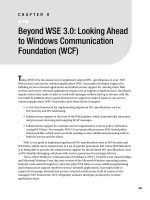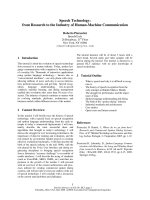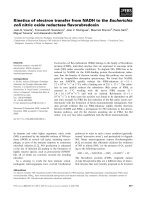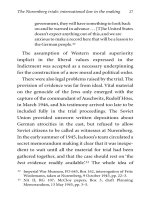Ebook Marketing 3.0: From products to customers to the human spirit - Part 1
Bạn đang xem bản rút gọn của tài liệu. Xem và tải ngay bản đầy đủ của tài liệu tại đây (923.95 KB, 136 trang )
From Products to
Customers to
the Human
Spirit
marketing
3.0
PHILIP KOTLER
HERMAWAN KARTAJAYA IWAN SETIAWAN
marketing
3.0
marketing
3.0
From Products to
Customers to
the Human
Spirit
PHILIP KOTLER
HERMAWAN KARTAJAYA IWAN SETIAWAN
JOHN WILEY & SONS, INC.
Copyright C by 2010 by Philip Kotler, Hermawan Kartajaya,
and Iwan Setiawan. All rights reserved.
Published by John Wiley & Sons, Inc., Hoboken, New Jersey.
Published simultaneously in Canada.
No part of this publication may be reproduced, stored in a retrieval system,
or transmitted in any form or by any means, electronic, mechanical,
photocopying, recording, scanning, or otherwise, except as permitted
under Section 107 or 108 of the 1976 United States Copyright Act, without
either the prior written permission of the Publisher, or authorization
through payment of the appropriate per-copy fee to the Copyright
Clearance Center, Inc., 222 Rosewood Drive, Danvers, MA 01923,
(978) 750-8400, fax (978) 646-8600, or on the web at www.copyright.com.
Requests to the Publisher for permission should be addressed to the
Permissions Department, John Wiley & Sons, Inc., 111 River Street,
Hoboken, NJ 07030, (201) 748-6011, fax (201) 748-6008, or online at
/>Limit of Liability/Disclaimer of Warranty: While the publisher and author
have used their best efforts in preparing this book, they make no
representations or warranties with respect to the accuracy or completeness
of the contents of this book and specifically disclaim any implied
warranties of merchantability or fitness for a particular purpose. No
warranty may be created or extended by sales representatives or written
sales materials. The advice and strategies contained herein may not be
suitable for your situation. You should consult with a professional where
appropriate. Neither the publisher nor author shall be liable for any loss of
profit or any other commercial damages, including but not limited to
special, incidental, consequential, or other damages.
For general information on our other products and services or for technical
support, please contact our Customer Care Department within the
United States at (800) 762-2974, outside the United States at
(317) 572-3993 or fax (317) 572-4002.
Wiley also publishes its books in a variety of electronic formats. Some
content that appears in print may not be available in electronic books. For
more information about Wiley products, visit our web site at
www.wiley.com.
ISBN 978-0-470-59882-5
Printed in the United States of America.
10 9
8
7
6
5
4
3 2
1
“To the next generation of Marketers who will enhance
the social and environmental contributions of the
marketing discipline.”
Philip Kotler
“To my first grandson, Darren Hermawan, The Next
Great Marketer.”
Hermawan Kartajaya
“To Louise for her endless support.”
Iwan Setiawan
CONTENTS
Foreword
ix
Preface
xi
About the Authors
xv
PART I
Trends
Chapter One
Welcome to Marketing 3.0
3
Chapter Two
Future Model for Marketing 3.0
25
PART II
Strategy
Chapter Three
Marketing the Mission to the Consumers
51
Chapter Four
Marketing the Values to the Employees
69
Chapter Five
Marketing the Values to the Channel Partners
87
Chapter Six
Marketing the Vision to the Shareholders
vii
101
viii
CONTENTS
PART III
Application
Chapter Seven
Delivering Socio-Cultural Transformation
121
Chapter Eight
Creating Emerging Market Entrepreneurs
137
Chapter Nine
Striving for Environmental Sustainability
153
Chapter Ten
Putting It All Together
169
Index
181
FOREWORD
According to Alvin Toffler, human civilization can be divided
into three waves of the economy. The first wave is the Agriculture Age, in which the most important capital is the land
for agriculture. My country, Indonesia, is undoubtedly rich in
this type of capital. The second is the Industrial Age following
the Industrial Revolution in England and the rest of Europe.
The essential kinds of capital in this age are machines and the
factory. The third era is the Information Age, where mind, information, and high tech are the imperative types of capital to
succeed. Today, as humanity embraces the challenge of global
warming, we are moving toward the fourth wave, which is oriented to creativity, culture, heritage, and the environment. In
leading Indonesia, this is my future direction.
When I read this book, I could see that marketing is also
moving toward the same direction. Marketing 3.0 relies heavily on the marketers’ ability to sense human anxieties and
desires, which are rooted in creativity, culture, heritage, and
the environment. This is even more relevant for Indonesia because the country is known for its diversity in culture and
heritage. Indonesia is also a very values-driven country. Spirituality has always been the central part of our lives.
I am happy with the examples in the book of successful multinational companies that support Millenium Development Goals for reducing poverty and unemployment in developing countries. I believe that public-private partnership
has always been a strong fundamental for economic growth,
especially in a developing country. This book is also very
ix
x
FOREWORD
supportive for my mission to shift poor people at the bottom
of the pyramid in Indonesia to the middle of the pyramid. It
also supports the nation’s efforts to preserve the environment
as our strongest asset.
In summary, I am proud to have two renowned marketing
gurus putting their energy and effort into writing a book for
a better world. Congratulations for Philip Kotler, Hermawan
Kartajaya, and Iwan Setiawan for this mind-stimulating book.
I hope that anyone who reads this book will be encouraged to
make a difference in the world we are living in.
—Susilo Bambang Yudhoyono
President of the Republic of Indonesia
PREFACE
The world is going through a period of rapid and wrenching
changes. The recent financial meltdown has unfortunately increased the level of poverty and unemployment, developments
that are now being fought with stimulus packages around the
world to restore confidence and economic growth. In addition,
climate change and rising pollution are challenging countries
to limit the release of carbon dioxide into the atmosphere, but
at the cost of imposing a higher burden on business. Furthermore, the rich countries of the West are now experiencing a
much slower rate of growth, and economic power is rapidly
shifting to countries in the East that are experiencing higher
rates of growth. And finally, technology is shifting from the
mechanical world to the digital world—the Internet, computers, cell phones, and social media—which is having a profound impact on the behavior of producers and consumers.
These and other changes will require a major rethinking of marketing. The concept of marketing can be seen as
the balancing concept to that of macroeconomics. Whenever
the macroeconomic environment changes, so will consumer
behavior change, and this will lead marketing to change.
Over the past 60 years, marketing has moved from being
product-centric (Marketing 1.0) to being consumer-centric
(Marketing 2.0). Today we see marketing as transforming once
again in response to the new dynamics in the environment.
We see companies expanding their focus from products to
consumers to humankind issues. Marketing 3.0 is the
stage when companies shift from consumer-centricity to
xi
xii
PREFACE
human-centricity and where profitability is balanced with corporate responsibility.
We see a company not as a sole and self-sustaining operator in a competitive world but as a company that operates
with a loyal network of partners—employees, distributors,
dealers, and suppliers. If the company chooses its network
partners carefully, and their goals are aligned and the rewards are equitable and motivating, the company and its partners combined will become a powerful competitor. To achieve
this, the company must share its mission, vision, and values
with its team members so that they act in unison to achieve
their goals.
We describe in this book how a company can market its
mission, vision, and values to each of its major stakeholders.
The company gets its profits by creating superior value for its
customers and stakeholder partners. We hope that the company views its customers as its strategic starting point and
wants to address them in their full humanity and with attention to their needs and concerns.
The book is structured into three key parts. In Part I, we
summarize the key business trends that shape the humancentric marketing imperative and lay the foundation for Marketing 3.0. In Part II, we show how the company can market
its corporate vision, mission, and values to each of its key
stakeholders—consumers, employees, channel partners, and
shareholders. In Part III, we share their thoughts on several
key implementations of Marketing 3.0 for solving global issues such as wellness, poverty, and environmental sustainability and how corporations can contribute by implementing the human-centric business model. Finally, the Epilogue
chapter summarizes the 10 key ideas of Marketing 3.0 with
select examples of companies that embrace the concept in
their business model.
NOTE ON THE ORIGIN OF THIS BOOK
The idea of Marketing 3.0 was first conceptualized in Asia
back in November 2005 by a group of consultants at
Preface
xiii
MarkPlus, a Southeast Asian–based marketing services firm
led by Hermawan Kartajaya. After two years of co-creation to
enhance the concept, Philip Kotler and Hermawan Kartajaya
launched the draft manuscript at the 40th anniversary of the
Association of Southeast Asian Nations (ASEAN) in Jakarta.
The only G-20 member in Southeast Asia, Indonesia is a nation where human centricity and the character of spirituality overcome the challenges of diversity. The president of the
United States, Barack Obama, spent four years of his early
education in Indonesia to learn about the human centricity
of the East. Marketing 3.0 was born and shaped in the East,
and we are honored to have a Foreword by Susilo Bambang
Yudhoyono, President of the Republic of Indonesia.
Iwan Setiawan, one of the MarkPlus consultants who initiated the concept, collaborated with Philip Kotler at Northwestern University’s Kellogg School of Management—one of the
world’s top business schools in the West—to enhance the relevance of Marketing 3.0 with the emergence of the new world
economic order and the rise of the digital world.
ABOUT THE AUTHORS
Philip Kotler, the S.C. Johnson & Son Distinguished Professor of International Marketing at the Kellogg School of Management, Northwestern University, is also widely regarded
as the Father of Modern Marketing. He is ranked by the
Wall Street Journal as one of the top six most influential
business thinkers.
Hermawan Kartajaya is the founder and CEO of MarkPlus,
Inc., and is one of the “50 Gurus Who Have Shaped the Future
of Marketing,” according to the Chartered Institute of Marketing, United Kingdom.
Iwan Setiawan (Kellogg School of Management 2010) is a
senior consultant at MarkPlus, Inc.
xv
PART I
TRENDS
CHAPTER ONE
Welcome to
Marketing 3.0
WHY MARKETING 3.0?
Over the years, marketing has evolved through three stages
that we call Marketing 1.0, 2.0, and 3.0. Many of today’s marketers still practice Marketing 1.0, some practice Marketing
2.0, and a few are moving into Marketing 3.0. The greatest
opportunities will come to marketers practicing 3.0.
Long ago, during the industrial age—when the core technology was industrial machinery—marketing was about selling the factory’s output of products to all who would buy
them. The products were fairly basic and were designed to
serve a mass market. The goal was to standardize and scale
up to bring about the lowest possible costs of production so
that these goods could be priced lower and made more affordable to more buyers. Henry Ford’s Model T automobile epitomized this strategy; said Ford: “Any customer can have a car
painted any color that he wants so long as it is black.” This
was Marketing 1.0 or the product-centric era.
Marketing 2.0 came out in today’s information age—where
the core is information technology. The job of marketing is
no longer that simple. Today’s consumers are well informed
and can easily compare several similar product offerings. The
3
4
TRENDS
product value is defined by the consumer. Consumers differ greatly in their preferences. The marketer must segment
the market and develop a superior product for a specific target market. The golden rule of “customer is king” works well
for most companies. Consumers are better off because their
needs and wants are well addressed. They can choose from a
wide range of functional characteristics and alternatives. Today’s marketers try to touch the consumer’s mind and heart.
Unfortunately, the consumer-centric approach implicitly assumes the view that consumers are passive targets of marketing campaigns. This is the view in Marketing 2.0 or the
customer-oriented era.
Now, we are witnessing the rise of Marketing 3.0 or the
values-driven era. Instead of treating people simply as consumers, marketers approach them as whole human beings
with minds, hearts, and spirits. Increasingly, consumers are
looking for solutions to their anxieties about making the globalized world a better place. In a world full of confusion, they
search for companies that address their deepest needs for social, economic, and environmental justice in their mission,
vision, and values. They look for not only functional and emotional fulfillment but also human spirit fulfillment in the products and services they choose.
Like consumer-oriented Marketing 2.0, Marketing 3.0 also
aims to satisfy the consumer. However, companies practicing
Marketing 3.0 have bigger missions, visions, and values to
contribute to the world; they aim to provide solutions to address problems in the society. Marketing 3.0 lifts the concept
of marketing into the arena of human aspirations, values, and
spirit. Marketing 3.0 believes that consumers are complete
human beings whose other needs and hopes should never be
neglected. Therefore, Marketing 3.0 complements emotional
marketing with human spirit marketing.
In times of global economic crisis, Marketing 3.0 gains
more relevance to the lives of the consumers as they are impacted more by rapid social, economic, and environmental
change and turbulence. Diseases become pandemics, poverty
Welcome to Marketing 3.0
5
increases, and environmental destruction is under way. Companies practicing Marketing 3.0 provide answers and hope
to people confronting such issues and, therefore, touch consumers at a higher level. In Marketing 3.0, companies differentiate themselves by their values. In turbulent times, this
differentiation is arguably a strong one.
Table 1.1 summarizes the comparison of Marketing 1.0,
2.0, and 3.0 from comprehensive viewpoints.
To understand Marketing 3.0 better, let us examine the
rise of three major forces that shape the business landscape
toward Marketing 3.0: the age of participation, the age of globalization paradox, and the age of creative society. Observe how
these three major forces transform consumers to be more collaborative, cultural, and human spirit-driven. Understanding
this transformation will lead to a better understanding of Marketing 3.0 as a nexus of collaborative, cultural, and spiritual
marketing.
THE AGE OF PARTICIPATION AND
COLLABORATIVE MARKETING
Technological advances have brought about huge changes in
consumers, markets, and marketing over the past century.
Marketing 1.0 was initiated by production technology development during the Industrial Revolution. Marketing 2.0 came
into being as a result of information technology and the Internet. Now, new wave technology becomes the major driver for
the birth of Marketing 3.0.
Since early 2000, information technology has penetrated
the mainstream market and further developed into what is
considered the new wave technology. New wave technology
is technology that enables connectivity and interactivity of
individuals and groups. New wave technology consists of
three major forces: cheap computers and mobile phones, lowcost Internet, and open source.1 The technology allows individuals to express themselves and collaborate with others.
The emergence of new wave technology marks the era that
6
Sell products
Industrial Revolution
Mass buyers with physical
needs
Product development
Product specification
Functional
One-to-many transaction
Objective
Enabling forces
How companies see the
market
Key marketing concept
Company marketing
guidelines
Value propositions
Interaction with consumers
Marketing 1.0
Product-centric
Marketing
One-to-one relationship
Satisfy and retain the
consumers
Information technology
Smarter consumer with
mind and heart
Differentiation
Corporate and product
positioning
Functional and emotional
Marketing 2.0
Consumer-oriented
Marketing
Table 1.1 Comparison of Marketing 1.0, 2.0, and 3.0
Make the world a better
place
New wave technology
Whole human with mind,
heart, and spirit
Values
Corporate mission, vision,
and values
Functional, emotional, and
spiritual
Many-to-many collaboration
Marketing 3.0
Values-driven
Marketing
Welcome to Marketing 3.0
7
Scott McNealy, Chairman of Sun Microsystems, declared as
the age of participation. In the age of participation, people create news, ideas, and entertainment as well as consume them.
New wave technology enables people to turn from being consumers into prosumers.
One of the enablers of new wave technology is the rise of
social media. We classify social media in two broad categories.
One is the expressive social media, which includes blogs,
Twitter, YouTube, Facebook, photo sharing sites like Flickr,
and other social networking sites. The other category is the
collaborative media, which includes sites such as Wikipedia,
Rotten Tomatoes, and Craigslist.
Expressive Social Media
Let us examine the impact of expressive social media on marketing. In early 2008, Technorati found 13 million active blogs
around the world.2 As with readership of print media, readership of blogs varies among countries. Unlike in Japan where
74 percent of Internet users read blogs, only around 27 percent of Internet users in the United States read blogs. Although the readership is low, 34 percent of blog readers in
the United States are influencers. As a result, U.S. blogs stimulate follow-up actions by 28 percent of their readers.3 Seth
Godin, a well-known marketer, runs a popular web site that
offers a new idea every day to influence thousands of people
who have elected to receive his feed.
Another popular form of blogging, and one of the fastest
growing forms of social media is Twitter. From April 2008 to
April 2009, the number of Twitter users has grown 1,298
percent.4 The microblogging site allows members to broadcast tweets of 140 characters or fewer to their followers. It
is considered much simpler than blogging because users can
easily send tweets from handheld devices such as iPhones and
Blackberrys. Through Twitter, users can share their thoughts,
their activities, and even their moods with friends or fans. Actor Ashton Kutcher reportedly hit the 1 million followers mark
on Twitter, beating out even CNN.









